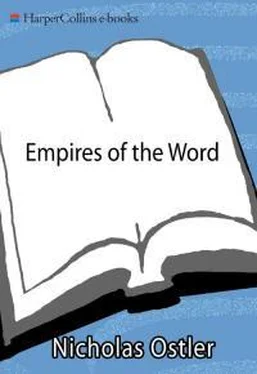Quechua is basically spelt and pronounced like Spanish, but w and k are common. Hence õ is ny as in canyon , and j is ch in as in loch. An apostrophe after a consonant marks a glottal catch in the voice. A major exception to Spanish convention is that q is pronounced with the uvula at the back of the mouth, as in Arabic; and immediately before or after it i is pronounced more like [e], and u as [o]. This is the fundamental reason why the language’s name is given sometimes as ‘Quechua’, and sometimes as ‘Quichua’. The first u is in any case just a reminiscence of Spanish spelling: the pronunciation is more like [qecwa].
Something of the same seems to have happened with the Mayan languages, but with less conscious collaboration with, or aping of, Spanish literary forms. The Mayans had not recently been united under indigenous leaders. Nevertheless, they did develop a literature, but it was one that largely followed the norms and content of their older traditions. It includes the heroic myths of the Popol Vuh, the elegiac and tragic dialogue with a doomed warrior (Rabinal Achi), and the Books of Chilam Balam, which are traditional almanacs. It was a form of underground resistance to Christian domination.
Motolinía was a Nahuatl pseudonym, adopted by him because it meant ‘poor’. The original name of this Franciscan friar had been Fray Toribio de Benavente.
The encomienda was an economic institution universal in the Spanish American colonies; it was a leasehold granted by the king, under which a designated encomendero was given full rights to exploit the labour of Indians on an estate, on condition only that the Indians received religious instruction.
‘Reverend Father, what case is it in?’
The echoes of this former majesty are widespread. Quechua was one of the eleven languages used by the Jesuits in their missions in Paraguay. It is also attested to this day, in small communities in the north of Chile, and Acre in the west of Brazil.
’para que de una vez se llegue a conseguir el que se extingan los diferentes idiomas de que se usa en los mismos Dominios, y sólo se hable el Castellano …’ , quoted in Triana y Antorveza ( 1987: 511).
The Portuguese Crown had expelled all Jesuits from Brazil in 1759. (See Chapter 11, ‘Portuguese pioneers’, p. 394.
Quotes from the Philippine constitution of 1987 (cited in Quilis 1992: 83).
The 2001 census figures place the Hispanic population of the USA at 37 million, 13 per cent of the total, and the largest minority in the country, having just now overtaken the African-Americans’ 36.1 million. The Hispanics are the only US minority to retain routine usage of their heritage language, Spanish, with two TV channels, Univisión and Telemundo, and over two hundred publications with a joint circulation of over 12 million ( El País newspaper, Madrid, 23 March 2003).
Camões is the doyen of Portuguese literature, and his great work celebrates the achievements of the Portuguese mariners. The name Lusiadas , although it recalls ‘Iliad’, is actually a learned equivalent for ‘the Portuguese’, meaning the progeny of Lusus, the mythical founder of the race who lived in (Roman) Lusitania. The work was actually written, for the most part, in Goa, so it is a product of Ultramar, as well as a celebration of it. It was published in 1572.
‘Father, what has brought you to this land so far from India?’ Reported in his Itinerario da Índia por terra , quoted in Lopes (1936: 33-5).
Now Bandar Khomeini, on the Straits of Hormuz.
It became the default European language in the Indies, and apparently in western Java, in the region of Preanger, even Dutch was known popularly as basa Perteges —an interesting conflation of language misnomers, with basa , through Malay bahasa , from Sanskrit bhā·ā , and Perteges a corruption of Portugues (reported in Lopes 1936: viii).
To compare with English dialects, Indo-Portuguese makes it like the E in a refined Scots pronunciation of ‘Edinburgh’, standard Portuguese more like the a in Cockney ‘mate’.
Even so, in 2000 the state’s official language was declared to be Konkani, an Aryan language related to Marathi and Hindi.
This was part of the global impact of the Enlightenment on Catholic governments (see Chapter 10, ‘The state’s solution: Hispanización’, p. 374).
Palembang in Sumatra was the principal city of Śrī Vijaya, the ancient state that was most likely responsible for the spread of Malay round the markets of the East Indies. This proverbial statement of wasted effort is said to refer to a failed Dutch attempt to take Palembang, in their day a prime source of pepper (Hamilton 1987: 60).
Each country had between 1.25 and 1.5 million people in the seventeenth century (Boxer 1969: 114).
The Batavi were a Germanic tribe who had lived in the area of modern Holland, north of the Scheldt, around the turn of the first centuries BC-AD. They thus provided a useful classical pseudonym for historically minded Dutchmen, perhaps little appreciated by the Javanese among whom they settled.
A major motive was the association of the Portuguese with Christianity, which the Japanese government of Tokugawa Iemitsu was determined to stamp out within their shores. The Dutch, prepared to restrict their concerns to secular matters of trade, were therefore the only foreign contact of the Japanese for the following two centuries.
This led to a famous linguistic incident in Japanese history (comparable to the use of Portuguese mentioned above, [’An Asian empire’, p. 388]). In 1853, when the American Commodore Perry entered the port of Uraga with his ‘black ships’, determined to end Japan’s isolation, one of the first Japanese to come alongside, Hori Tatsunosuke, said in very good English, ‘I can speak Dutch.’ Since one of the Americans, a Mr Portman, also knew the language, the first sustained exchange between an American and a Japanese actually took place in Dutch. (Hawks 1954, pp. 48-9)
They originally stepped in to take pre-emptive control of Dutch possessions when revolutionary France occupied the Netherlands in 1795, but permanently annexed the Cape colony in 1806.
Anderson (1991: 110) suggests two other motives: the absence of nationalism as such in the early seventeenth century (the VOC was after all a corporation, not a nationality), and Dutch lack of self-confidence in their own language. Neither seems particularly convincing, especially in comparison with the Portuguese competitors whom the Dutch were quite consciously outdoing. On p. 133, he suggests further that the Netherlands, with only one substantial colony, could afford to adopt a non-European language for administration: it would have been unworkable, he says, for a multi-continental empire such as the British. But the Dutch empire too, for its first 150 years, had been just as multi-continental.
On the other hand, he may be right in pointing (p. 110) to the language policy as a means of keeping the native population underdeveloped: ‘in 1940, when the indigenous population numbered well over 70 millions, there were only 637 “natives” in college, and only 37 graduated with BAs.’
Читать дальше











